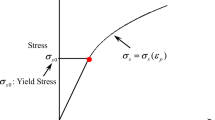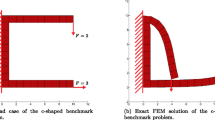Abstract
The structure should be focusing on the nonlinear behavior when an external load is applied and causes a large deformation. This research presents the topology optimization under bilinear elastoplastic and isotropic and kinematic hardening material properties. Optimization is performed using the solid isotropic material with penalization approach, and each element density is updated based on a proportional technique. The proportional technique is a non-sensitivity method proposed by combining with the fully stressed criterion for the topology optimization to be one factor of the update function. The cyclic load was applied to the structure and indicated an effect of stress fluctuation through the optimization process. Numerical examples were examined to investigate the final layout based on the nonlinear material properties under a nonlinear analysis. Finally, a new filtering density equation was proposed to avoid stress fluctuation during the optimization process. The optimal layout was clearly obtained while investigating the cyclic load effect.
Similar content being viewed by others
Abbreviations
- d j :
-
Non-filtered density at element jth
- E e :
-
Material properties of each design element
- E min :
-
Elastic modulus of void element
- E o :
-
Elastic modulus of solid element
- p :
-
Penalization factor
- q :
-
Exponential stress factor
- r ij :
-
Distance of center-to-center between two elements
- r 0 :
-
Prescribed filtering radius
- U i :
-
Elemental internal energy density
- W ij :
-
Weight filtering
- X i :
-
Element density
- Ω :
-
Reference design domain
- Ω mat :
-
Optimal subset of design domain
- η i :
-
Filtering density at element ith
- ∂ all :
-
Maximum limit of elemental stress
- ∂ i :
-
Elemental stress
- α i opt :
-
Optimal density value
- α I prev :
-
Element density from previous iteration
- α rem :
-
Remaining material amount
- α target :
-
Target of material distribution for optimum layout
References
Z. H. Zuo and Y. M. Xie, A simple and compact Python code for complex 3D topology optimization, Advances in Engineering Software, 85 (2015) 1–11.
E. Andreassen, A. Clausen, M. Schevenels, B. S. Lazarov and O. Sigmund, Efficient topology optimization in MATLAB using 88 lines of code, Structural and Multidisciplinary Optimization 43 (1) (2011) 1–16.
O. Sigmund, A 99 line topology optimization code written in Matlab, Structural and Multidisciplinary Optimization 21 (2) (2001) 120–127.
K. Lui and A. Tovar, An efficient 3D topology optimization code written in Matlab, Structural and Multidisciplinary Optimization 50 (6) (2014) 1175–1196.
S. Deng and K. Suresh, Multi-constrained 3D topology optimization via augmented topological level-set, Computers and Structures 170 (9) (2016) 1–12.
A. Otomori, T. Yamada, K. Izui and S. Nishiwaki, Matlab code for a level set-based topology optimization method using a reaction diffusion equation, Structural and Multidisciplinary Optimization 51 (5) (2015) 1159–1172.
J. A. Sethian and A. Wiegmann, Structural boundary design via level set and immersed interface methods, Journal of Computational Physics 163 (2) (2000) 489–528.
T. Y. Chen and Y. H. Chiou, Structural topology optimization using genetic algorithms, Proc. in the World Congress on Engineering 2013 London, U.K. (2013).
N. Hoshi and H. Hasegawa, Aco topology optimization: the pheromone control for considering the mechanical Kansei, Proc. in 17th International Conference on Modeling and Applied Simulation Budapest, Hungary (2018) 168–172.
G. S. Hailu, W. E. Dereje and H. M. Fakhruldin, A comparative study on stress and compliance based structural topology optimization, Proc. in IOP Conf. Series: Materials Science and Engineering, 24 (2017) 1–7.
Q. Xia and T. Shi, Stiffness optimization of geometrically nonlinear structures and the level set based solution, International Journal for Simulation and Multidisciplinary Design Optimization 7 (A3) (2016) 1–13.
T. Yamada, M. Manabe, K. Izui and S. Nishiwaki, A topology optimization method for geometrically nonlinear problems incorporating level set boundary expressions and a particle method, Journal of Advanced Mechanical Design, Systems, and Manufacturing 7 (4) (2013) 630–643.
F. A. M. Gomes and T. A. Senne, An algorithm for the topology optimization of geometrically nonlinear structures, International Journal for Numerical Methods in Engineering 99 (6) (2014) 391–409.
Y.-S. Eom and S.-Y. Han, A new topology optimization scheme for nonlinear structures, Journal of Mechanical Science and Technology 28 (7) (2014) 2779–2786.
D.-H. Chang, K.-S. Yoo, J.-Y. Park and S.-Y. Han, Optimum design for nonlinear problems using modified ant colony optimization, Proc. in 2012 International Conference on Software and Computer Applications Singapore (2012) 45–49.
G.-H. Yoon and Y.-Y. Kim, Topology optimization of materialnonlinear continuum structures by the element connectivity parameterization, International Journal for Numerical Methods in Engineering 69 (10) (2007) 2196–2218.
G.-H. Yoon, Y.-S. Joung and Y.-Y. Kim, Optimal layout design of three-dimensional geometrically non-linear structures using the element connectivity parameterization method, International Journal for Numerical Methods in Engineering 69 (6) (2007) 1278–1304.
N. M. Patel, B.-S. Kang, J. E. Renaud and A. Tovar, Crashworthiness design using topology optimization, Journal of Mechanical Design 131 (6) (2009) 061013-1–0610163-12.
X. Huang and Y.M. Xie, Topology optimization of nonlinear structures under displacement loading, Engineering Structures 30 (7) (2008) 2057–2068.
T. Buhl, C. B. W. Pedersen and O. Sigmund, Stiffness design of geometrically nonlinear structures using topology optimiza, Journal of Mechanical Science and Technology 34 (4) 2020
H. C. Gea and J. Luo, Topology optimization of structures with geometrical nonlinearities, Computers and Structures 79 (20-21) (2001) 1977–1985.
E. Biyikli and A. C. To, Proportional topology optimization: a new non-sensitivity method for solving stress constrained and minimum compliance problems and its implementation in MATLAB, PLoS ONE 10 (12) (2015) 1–23.
F. Zhifang, Z. Junpeng and W. Chunjie, Robust topology optimization under loading uncertainty with proportional topology optimization method, Proc. in 2016 Eight International Conference on Measuring Technology and Mechatronics Automation Macau, China (2016) 584–588.
M. Cui, Y. Zhang, X. Yang and C. Luo, Multi-material proportional topology optimization based on the modified interpolation scheme, Engineering with Computers 34 (2) (2018) 287–305.
O. Sigmund, Morphology-based black and white filters for topology optimization, Structural and Multidisciplinary Optimization 33 (4-5) (2007) 401–424.
J. K. Guest, J. H. Prévost and T. Belytschko, Achieving minimum length scale in topology optimization using nodal design variables and projection functions, International Journal for Numerical Methods in Engineering 61 (2) (2004) 238–254.
J. K. Guest, Topology optimization with multiple phase projection, Computer Methods in Applied Mechanics and Engineering 199 (1-4) (2009) 123–135.
S. Kongwat and H. Hasegawa, Optimization on mechanical structure for material nonlinearity based on proportional topology method, Journal of Advanced Simulation in Science and Engineering 6 (2) (2019) 354–366.
M. P. Bendsoe and O. Sigmund, Topology Optimization: Theory, Methods and Applications New York, Springer-Verlag (2003).
A. Li, C. Liu and S. Feng, Topology and thickness optimization of an indenter under stress and stiffness constraints, Journal of Mechanical Science and Technology 32 (1) (2018) 211–222.
M. P. Bendsoe and O. Sigmund, Material interpolation schemes in topology optimization, Archive of Applied Mechanics 69 (9-10) (1999) 635–654.
U. Kirsch, Structural Optimization: Fundamentals and Applications New York, Springer-Verlag (1993).
L. Xia, F. Fritzen and P. Breitkopf, Evolutionary topology optimization of elastoplastic structures, Structural and Multidisciplinary Optimization 55 (2) (2017) 569–581.
Author information
Authors and Affiliations
Corresponding author
Additional information
Recommended by Editor Seungjae Min
Suphanut Kongwat is currently a doctoral candidate of Department of Functional and Control Systems at Shibaura Institute of Technology (SIT), Saitama, Japan. He received B.Eng. and M.Eng. in Mechanical Engineering from King Mongkut’s University of Technology Thonburi (KMUTT), Bangkok, Thailand in 2013 and 2016, respectively. He also received M.S. in Systems Engineering and Science from SIT in 2017.
Hiroshi Hasegawa received his B.Eng. and M.Eng. from Shibaura Institute of Technology (SIT), Saitama, Japan in 1992 and 1994, respectively. He received his Dr.Eng. in Mechanical Engineering from the Tokyo Institute of Technology, Tokyo, Japan in 1998. He is currently a Professor at SIT in the Department of Machinery and Control Systems, College of Systems Engineering and Science. He is a member of JSEE, JSME, ASME, JSCES, JSST, and KES. His research interests include computer-aided exploration, creativity of design, and systems engineering.
Rights and permissions
About this article
Cite this article
Kongwat, S., Hasegawa, H. New weight filtering factor of nonlinear design for topology optimization under cyclic loading based on proportional technique. J Mech Sci Technol 34, 1635–1644 (2020). https://doi.org/10.1007/s12206-020-0326-x
Received:
Revised:
Accepted:
Published:
Issue Date:
DOI: https://doi.org/10.1007/s12206-020-0326-x




